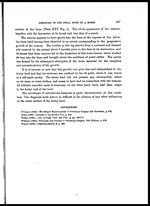Medicine - Veterinary > Veterinary colleges and laboratories > Indian journal of veterinary science and animal husbandry > Volume 2, 1932 > Original articles > Abstracts
(371) Page 318
Download files
Individual page:
Thumbnail gallery: Grid view | List view

ABSTRACTS
Immunity in East Coast Fever—DU TOIT, P. J.—[Reprinted from the Veterinary
Bulletin, Vol. 2, No. 2, February 1932.]
It is well-known that immunity to " East Coast fever " can be broken down by exposure to
natural infection by ticks, but, up to the present, there is no experimental evidence to show that a
recovered animal can suffer a relapse in the absence of exposure to infected ticks. New outbreaks
of the disease are frequently accounted for by farmers and others on the grounds that such
breakdowns of immunity do occur, thus making the starting point of a new centre of infec-
tion.
In 1928, the author reported experiments which aimed at producing such relapses without the
intervention of ticks, but the details were not given; these are now included in the present paper
for the sake of completeness and case of reference. In the first experiments, substances which are
known to be capable of producing relapses in other protozoan diseases were injected ; a condition of
anæmia was produced by venesection and by the injection of ichthargan. Splenectomy was
performed, attempts were made to set up peritonitis and to produce metritis and abortion, and
animals were infected with trypanosomes and "heartwater"
Finally, a camp was established on a farm where recovered and susceptible animals were kept
together for a period of three years, the number of animals within the camp being maintained at
about 30 during the period. The area of the camp was about 200 acres and the grazing was such
that 30 animals were as many as it would support. These animals were kept under very careful
observation. Although a large variety of protozoan infections developed in animals concerned in
some or other of the experiments, no case of "East coast fever" occurred. Infection with
The mutans occurred and the author explains his reasons for feeling absolutely confident that no
confusion arose between these parasites and Th. parva. The essential reason was that no acute
fatal infection occurred. [A. LESLIE SHEATHER.]
Some activities of the Bureau of Animal Industry—MOHLER, J. R.—[Reprinted
from the Veterinary Bulletin, Vol. 2, No. 2, February 1932.]
In this address, delivered at the Twenty-third Annual Conference for veterinarians at Cornell
University, Dr. Mohler, Chief of the Bureau of Animal Industry, U.S.A., briefly surveyed the
manifold activities of his department.
He pointed out that profitable livestock production is obviously essential for successful agricul-
ture and that, without the intervention of veterinary science, herds and flocks would be deci-
mated by disease to such an extent as to render production unprofitable.
In January, 1930, the value of livestock in the U.S.A., exclusive of poultry, was estimated at
$6,000 million which exceeded the aggregate value of all the corn, oats, wheat, rye, barley, buck-
wheat, potatoes, tobacco and cotton produced in the U.S.A. during the year 1929.
The estimated annual loss from contagious disease suffered by the livestock industry was approxi-
mately 300 million dollars and, in the opinion of the author, at least two-thirds of that loss
(318)
Set display mode to: Large image | Zoom image | Transcription
Images and transcriptions on this page, including medium image downloads, may be used under the Creative Commons Attribution 4.0 International Licence unless otherwise stated. ![]()
| India Papers > Medicine - Veterinary > Veterinary colleges and laboratories > Indian journal of veterinary science and animal husbandry > Volume 2, 1932 > Original articles > Abstracts > (371) Page 318 |
|---|
| Permanent URL | https://digital.nls.uk/75228348 |
|---|
| Description | Covers articles from 1932. |
|---|




